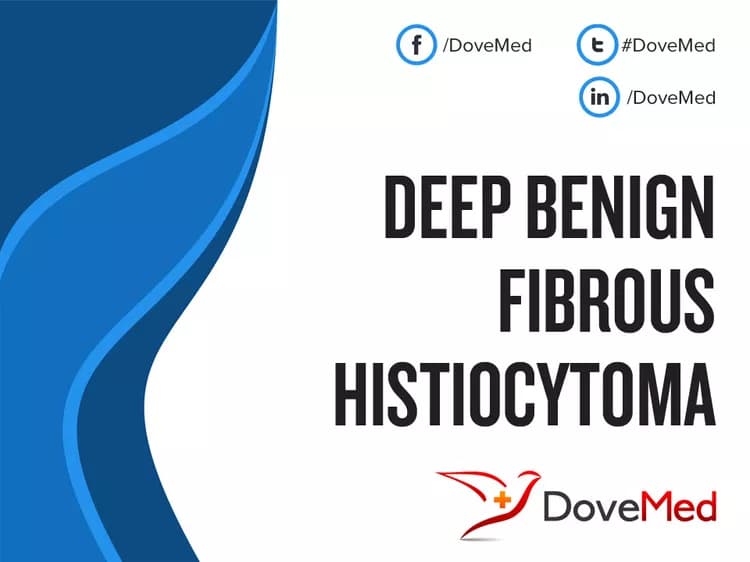What are the other Names for this Condition? (Also known as/Synonyms)
- Deep Fibrous Histiocytoma
What is Deep Benign Fibrous Histiocytoma? (Definition/Background Information)
- Deep Benign Fibrous Histiocytoma is a benign soft tissue tumor occurring deep below the skin (in 90% of the cases). These slow-growing solitary tumors are generally well-defined, painless, and have a rare occurrence
- This tumor occurs deep within the soft tissues, or involves the organs of the body, without any skin involvement. When the skin is involved, it is called Benign Fibrous Histiocytoma
- Unlike Benign Fibrous Histiocytoma that are very common tumor types, Deep Benign Fibrous Histiocytoma tumors are rare
- Deep Benign Fibrous Histiocytoma usually affects the lower limbs. Other tumor areas include the head and trunk. Young and old adults are commonly affected
- Surgical excision and removal of the entire tumor is the treatment of choice. The prognosis in such cases, is excellent
Who gets Deep Benign Fibrous Histiocytoma? (Age and Sex Distribution)
- Deep Benign Fibrous Histiocytoma lesions are generally present in individuals over the age of 25 years (especially males). Though, it has a wide age range (from 6-84 years), it is rarely seen in children
- Males are affected more than the females
- There is no racial or ethnic preference noticed
What are the Risk Factors for Deep Benign Fibrous Histiocytoma? (Predisposing Factors)
No risk factors are evident for Deep Benign Fibrous Histiocytoma.
It is important to note that having a risk factor does not mean that one will get the condition. A risk factor increases ones chances of getting a condition compared to an individual without the risk factors. Some risk factors are more important than others.
Also, not having a risk factor does not mean that an individual will not get the condition. It is always important to discuss the effect of risk factors with your healthcare provider.
What are the Causes of Deep Benign Fibrous Histiocytoma? (Etiology)
- The exact cause and mechanism of Deep Benign Fibrous Histiocytoma formation, is unknown
- They are thought to occur spontaneously
What are the Signs and Symptoms of Deep Benign Fibrous Histiocytoma?
Signs and symptoms of Deep Benign Fibrous Histiocytoma include:
- They are slow-growing, painless, solitary, soft tissue tumors, observed mostly deep below the skin surface (normally about 4cm in size at detection)
- Sometimes, these tumors are found deep inside the body tissues (in which case they may be over 9cm in size at diagnosis). They may appear as painful mass lesions after many years
- Deep Fibrous Histiocytoma tumors can grow anywhere from 0.5 cm to 25 cm in size
- Most common locations of these lesions are the legs. Other locations include the head, neck, body trunk, and occasionally the pelvis, trachea, kidney, and abdomen
How is Deep Benign Fibrous Histiocytoma Diagnosed?
Deep Benign Fibrous Histiocytoma is diagnosed using the following tools:
- Physical exam with evaluation of medical history
- CT scan, MRI scan of the affected regions
- Histopathological studies conducted on a biopsy specimen - the specimen is examined under a microscope by a pathologist, to arrive at a definitive diagnosis. A high cell division is noted with this tumor type
- Since Deep Benign Fibrous Histiocytoma is a frequently misdiagnosed tumor, a differential diagnosis is used to eliminate various other types of tumors, which include:
- Synovial sarcoma
- Hemangiopericytoma
- Endometrial stromal sarcoma
- Glomangiopericytoma
- Myopericytoma
- Sinonasal hemangiopericytoma
- Glomus tumor
- Cellular angiofibroma
- Myofibroma (infantile hemangiopericytoma)
- Solitary fibrous tumor
- Leiomyosarcoma
- Mesenchymal chondrosarcoma
- Infantile fibrosarcoma
Many clinical conditions may have similar signs and symptoms. Your healthcare provider may perform additional tests to rule out other clinical conditions to arrive at a definitive diagnosis.
What are the possible Complications of Deep Benign Fibrous Histiocytoma?
Complications due to Deep Benign Fibrous Histiocytoma could include:
- Recurrence of the tumor after surgery (if the surgery does not entirely remove the tumor)
- Metastasis of the tumor leading to death. However, this is an extremely rare occurrence
- Damage to vital nerves, blood vessels, and surrounding structures, during surgery
How is Deep Benign Fibrous Histiocytoma Treated?
Treatment measures for Deep Benign Fibrous Histiocytoma include the following:
- Surgical excision with complete removal of the entire lesion is normally sufficient treatment
- If there is any pain, it is controlled through pain medications
- In order to prevent tumor recurrence, radiation therapy may be administered
- Post-operative care is important: A minimum activity level is to be ensured until the surgical wound heals
- Follow-up care with regular screening and check-ups are important
How can Deep Benign Fibrous Histiocytoma be Prevented?
- Current medical research has not established a way of preventing Deep Benign Fibrous Histiocytoma formation
- Regular medical screening at periodic intervals with blood tests, radiological scans, and physical examinations, are mandatory for those who have been diagnosed with the tumor
- Due to both its metastasizing potential and chances of recurrence, often several years of active follow-up vigilance is necessary
What is the Prognosis of Deep Benign Fibrous Histiocytoma? (Outcomes/Resolutions)
- The probability of Deep Benign Fibrous Histiocytoma recurrence is low after surgical removal of the tumor, and so is the risk from metastases. Nevertheless, periodic follow-up with medical screening is strongly recommended
- Prognosis is generally excellent when the lesions are small and found closer to the skin surface. Their recurrence risk can also be completely avoided, with a proper surgical excision and removal
Additional and Relevant Useful Information for Deep Benign Fibrous Histiocytoma:
- Deep Benign Fibrous Histiocytoma accounts for less than 1% of all fibrous histiocytomas
- It is characterized by the presence of oval or spindle shaped cells, arranged in a prominent spiral-like fashion
Related Articles
Test Your Knowledge
Asked by users
Related Centers
Related Specialties
Related Physicians
Related Procedures
Related Resources
Join DoveHubs
and connect with fellow professionals


0 Comments
Please log in to post a comment.